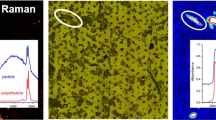Summary
An attempt of the time-resolution of emission spectra was carried out using a simple pulse generator by impressing a gate pulse on the dynodes of a photomultiplier tube in the direct-reading spectrometer. Examinations were made on the variation of the intensity of spectral line with time in various atmospheres and it was confirmed that the after-glow is the longest in an argon atmosphere.
The possibility of avoiding the effect of an interfering spectral line lying close to the analytical line was examined and this was proved to be possible with the analytical line of Si I 2881.58 å and the interfering line of Cr II 2881.93 å. The analytical line of calcium, Ca II 3933.67 å, is interfered by Fe I 3933.61 å and the effect of the spectral line of iron was avoided by the use of the time-resolving technique. This permitted the rapid determination of 0.001∼0.1% of calcium in iron ores by the direct-reading spectrographic analysis.
Zusammenfassung
Ein Versuch der zeitlichen Auflösung von Emissionsspektren wurde durchgeführt unter Verwendung eines einfachen Impulsgenerators, indem man den Eröffnungsimpuls auf die Dynoden eines Photovervielfachers in einem direktschreibenden Spektrometer überlagert. Untersucht wurde die VerÄnderung der LinienintensitÄt in verschiedenartigen AtmosphÄren. Man konnte bestÄtigen, da\ das Nachglimmen in ArgonatmosphÄre am lÄngsten dauert.
Auch die Möglichkeit der Vermeidung der Störung durch benachbarte Spektrallinien wurde untersucht und gefunden, da\ die Vermeidung der Störung bei der Linie Si I 2881,58 å und der Störlinie Cr II 2881,93 å möglich ist. Die Analysenlinie Ca II 3933,67 å wird durch die Linie Fe I 3933,61 å gestört, was durch die Zeitauflösungstechnik vermieden wird. Dadurch wird es möglich, 0,001–0,1% Calcium in Eisenerzen durch direktschreibende spektrographische Analyse zu bestimmen.
Similar content being viewed by others
References
Bardócz, A.: Appl. Spectr. 11, 167 (1957).
GotÔ, H., H. Furukawa, and E. SudÔ: Rep. 5964, 19th Comm. Japan Soc. Prom. Sci. (1960).
Laqua, K., and W.-D. Hagenah: Spectrochim. Acta 18, 183 (1962); cf. Z. Anal. Chem. 193, 113 (1963).
Steinhaus, D. W., H. M. Crosswhite, and G. H. Dieke: J. Opt. Soc. Am. 43, 257 (1953).
Suzuki, N.: Japan J. Appl. Phys. 3, 705 (1964).
Suzuki, N.: J. Spectroscop. Soc. Japan 13, 131 (1965).
Yokoyama, Y.: J. Japan Inst. Metals (Sendai) 24, 802 (1960).
Author information
Authors and Affiliations
Rights and permissions
About this article
Cite this article
GotÔ, H., Ikeda, S., SaitÔ, A. et al. Direct-reading, time-resolving technique in emission spectroscopy and its application to the analysis of iron, steel and iron ores. Z. Anal. Chem. 220, 95–104 (1966). https://doi.org/10.1007/BF00516471
Received:
Issue Date:
DOI: https://doi.org/10.1007/BF00516471




